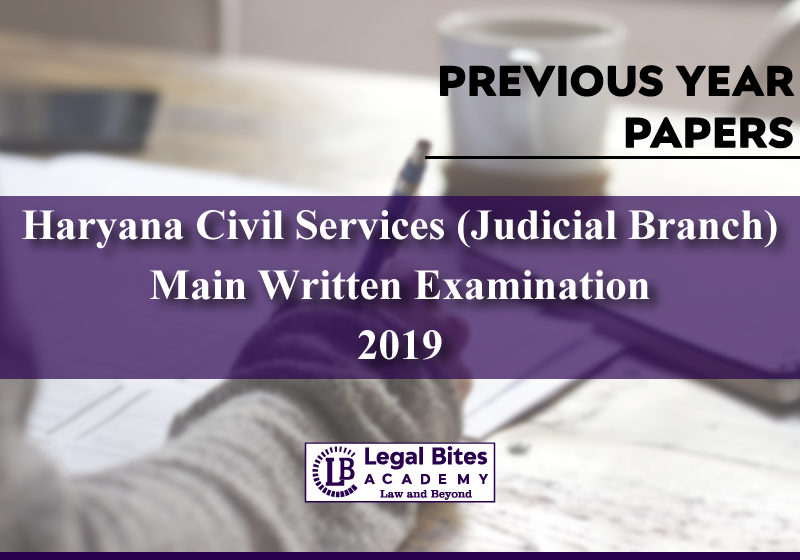Haryana Judicial Services Mains 2019 Previous Year Paper (Civil Law - I)
Candidates preparing for Haryana Judicial Services should solve the Haryana Judicial Services Mains 2019 Previous Year Paper and other previous year question papers before they face Prelims and Mains. Additionally, it gives an idea about the syllabus and the way to prepare the subjects by keeping the previous year questions in mind. All toppers are mindful and cognizant… Read More »

Candidates preparing for Haryana Judicial Services should solve the Haryana Judicial Services Mains 2019 Previous Year Paper and other previous year question papers before they face Prelims and Mains.
Additionally, it gives an idea about the syllabus and the way to prepare the subjects by keeping the previous year questions in mind. All toppers are mindful and cognizant of the types of questions asked by the HCS, to be aware of the various different tricks and types of questions. This should be done by every aspirant when starting their preparation. It is very important to have an overall understanding of the pattern and design of questions.
Only practising the authentic question papers will give you a real feel of the pattern and style of the questions. Here’s Haryana Judicial Services Mains 2019 Previous Year Paper (Civil Law – I).
Haryana Civil Services (Judicial Branch) Main Written Examination 2019
CIVIL LAW – I
Time: 3 Hours
Maximum Marks: 200
Instructions:
- Attempt all the questions in the same order in which they appear in the Question Paper.
- Marks for individual questions are indicated against each question.
- Support your answers with relevant provisions and case law.
- No extra answer sheet will be provided.
Question 1
A. Explain the concept of Precept under the Code of Civil Procedure and also the circumstances under which an order for attachment before judgment, is passed by a civil court. (20 marks)
B. Explain the difference between implications of the rejection of plaint and return of plaint. (10 marks)
C. Explain the concept of Remand and Partial remand under the Code of Civil Procedure. (10 marks)
Question 2
A. Explain different methods by which a contract can be discharged under the Indian Contract Act. (10 marks)
B. Differentiate the consequences of mistake of law and mistake of fact with illustrations. (10 marks)
C. What are reciprocal promises? Discuss the provisions in the Indian Contract Act relating to the performance of reciprocal promises. (10 marks)
D. Explain the essentials of a valid tender. (10 marks)
Question 3
A. X entered into a contract to sell a piece of land to Y for Rs. 50 lakhs. Y’s elder brother Z paid half of the consideration to Y in a belief that he (Z) would be entitled to half portion of that particular land. Sale deed was made in favour of Y only. Z claimed that land was jointly owned by Y and Z therefore, his name was also to be included in that particular sale deed. Is Z entitled to any remedy according to Specific Relief Act, 1963? Decide by citing relevant judicial pronouncements. (15 marks)
B. What are the fundamental rules of pleadings? What are the circumstances in which court can order amendment of pleadings? Explain by citing appropriate statutory provisions and judicial decisions. (15 marks)
C. Discuss the conditions when the court may grant the remedy in the form of cancellation of instruments. Draw a distinction between cancellation and rectification of instruments. (10 marks)
Question 4
A.
- Whether it is mandatory for court to frame issue regarding maintainability of suit? Explain by citing relevant legal provisions and judicial decisions. (5 marks)
- Whether party can be permitted to file documents which were not filed along with written statement? Explain by citing relevant legal provisions and judicial decisions. (5 marks)
B. Explain the implications of limited liability partnership under the Indian Partnership Act. (10 marks)
C. The doctrine of caveat emptor is an integral part of the Sale of Goods Act. Explain the significance of the same. (10 marks)
D. Explain the implications of Admission and Confession under the Indian Evidence Act. (10 marks)
Question 5
A. Explain the concept of Res Gestae under the Evidence Act citing prominent cases on the point. (10 marks)
B. Explain the significance of presumptions of law under the Evidence Act with illustrations for each. (10 marks)
C. Explain the salient features of the Haryana Urban (Control of Rent and Eviction) Act, 1973. (10 marks)
D. Short notes on the followings: (2 x 5 = 10 marks)
- Expert Evidence
- Cross-Appeal
- Consequence of Article 18 of the Limitation Act.
- Caveat
- Restitution Application

